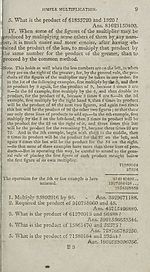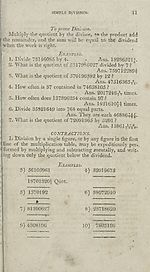Download files
Complete book:
Individual page:
Thumbnail gallery: Grid view | List view

I 10 3
SIMPLE DIVISION.
SlMPLE Division is the finding how often one simpl
number ^contained in another f or the dividing of any give
simple number into any proposed number of equal parts.
i’he containing number, or number to be divided, is ca
led the dividend.
The contained number, or the number of parts.into whicl
the dividend is divided, is called the divisor.
The number of times the dividend contains the divisor
or the number which expresses one of the equal parts, is cal
led the quotient. Thus :
Dividend
DivisorS) 12 (!• Quotient
Note. Division is a compendious subtraction, the quotient being the
number of subtractions in the operation.
Simple Division may be performed by the following
llvLE.
1. Having written down the divisor and dividend, as in the
font! above, consider if the divisor be less than, or equal to,
the sam^ number of the leu-hand figures of the dividend;
if'so, write the figure expressing the number of times it is
contained in the quotient; but if not, take one place more
of the dividend figures than are in the divisor, and write the
number of times they contain it in the quotient as before.
2. Multiply the divisor by the quotient figure.
3. Subtract the product from the same dividend figures.
4. To the remainder affix the next dividend figure, and
write in the quotient the number of times the divisor is con¬
tained in thi^ number ; multiply the divisor by the last quo¬
tient figure, and subtract the product from the last mention¬
ed number ; then proceed as before from the beginning of
this article, till all the dividend figures are used.
Kote 1. It i* sometimes troublesome to find how often the divisor is con¬
tained in the several dividuals; but part of the trouble will be saved
by observing, that when any product exceeds its dividual, the quo¬
tient figure belonging to such product must be lessened till the pro¬
duct be equl to, or less than, its dividual; again, if after subtracting
the product from its dividual, the remainder be equal to, or exceed
the divisor, the quotient figure must be increased till the remainder
be less than it.
2. To complete the quotient, set the last remainder (if any) at the end
of it, above a small lice with the divisor below iv
SIMPLE DIVISION.
SlMPLE Division is the finding how often one simpl
number ^contained in another f or the dividing of any give
simple number into any proposed number of equal parts.
i’he containing number, or number to be divided, is ca
led the dividend.
The contained number, or the number of parts.into whicl
the dividend is divided, is called the divisor.
The number of times the dividend contains the divisor
or the number which expresses one of the equal parts, is cal
led the quotient. Thus :
Dividend
DivisorS) 12 (!• Quotient
Note. Division is a compendious subtraction, the quotient being the
number of subtractions in the operation.
Simple Division may be performed by the following
llvLE.
1. Having written down the divisor and dividend, as in the
font! above, consider if the divisor be less than, or equal to,
the sam^ number of the leu-hand figures of the dividend;
if'so, write the figure expressing the number of times it is
contained in the quotient; but if not, take one place more
of the dividend figures than are in the divisor, and write the
number of times they contain it in the quotient as before.
2. Multiply the divisor by the quotient figure.
3. Subtract the product from the same dividend figures.
4. To the remainder affix the next dividend figure, and
write in the quotient the number of times the divisor is con¬
tained in thi^ number ; multiply the divisor by the last quo¬
tient figure, and subtract the product from the last mention¬
ed number ; then proceed as before from the beginning of
this article, till all the dividend figures are used.
Kote 1. It i* sometimes troublesome to find how often the divisor is con¬
tained in the several dividuals; but part of the trouble will be saved
by observing, that when any product exceeds its dividual, the quo¬
tient figure belonging to such product must be lessened till the pro¬
duct be equl to, or less than, its dividual; again, if after subtracting
the product from its dividual, the remainder be equal to, or exceed
the divisor, the quotient figure must be increased till the remainder
be less than it.
2. To complete the quotient, set the last remainder (if any) at the end
of it, above a small lice with the divisor below iv
Set display mode to:
![]() Universal Viewer |
Universal Viewer | ![]() Mirador |
Large image | Transcription
Mirador |
Large image | Transcription
| Antiquarian books of Scotland > Education > Complete treatise on practical arithmetic and book-keeping > (24) |
|---|
| Permanent URL | https://digital.nls.uk/114433858 |
|---|
| Description | Thousands of printed books from the Antiquarian Books of Scotland collection which dates from 1641 to the 1980s. The collection consists of 14,800 books which were published in Scotland or have a Scottish connection, e.g. through the author, printer or owner. Subjects covered include sport, education, diseases, adventure, occupations, Jacobites, politics and religion. Among the 29 languages represented are English, Gaelic, Italian, French, Russian and Swedish. |
|---|

